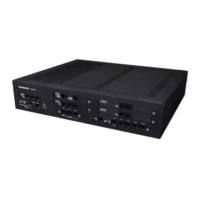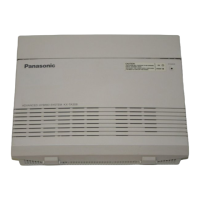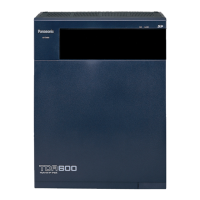Common Extension Numbering for 2 PBXs
Two PBXs can have extensions with the same leading number. TIE Line calling is available using extension
numbering.
PBX-1
TIE Line
PBX-2
InterfaceInterface
Extn.1033
Extn.1011 Extn.1012
TIE Line Network
Outside Caller
CO Line
CO Line
Dials "123-4567".
Telephone Company
Destination: 1033
DID No.: 4567
Dials "1033".
Explanation:
The PBX first searches local extensions for a matching number. If a dialed number is not found at the local
PBX, the call can then be sent to a remote PBX, and the remote PBX checks the TIE Line Routing Table for
a corresponding entry.
Case 1:
Extension 1012 of PBX-1 dials extension number
"1011".
® The dialed number is found at the local PBX, and extension 1012 of PBX-1 is connected to extension 1011
of PBX-1.
Case 2:
Extension 1012 of PBX-1 dials extension number "1033".
® The dialed number is not found at the local PBX, so the call is redirected to the specified TIE Line, and
extension 1012 of PBX-1 is connected to extension 1033 of PBX-2.
Case 3:
A public CO line call directed to extension 1033 arrives at PBX-1.
® The target extension number is not found at the local PBX, so the call is redirected to the specified TIE Line,
and the call is connected to extension 1033 of PBX-2.
– System programming is required to enable this feature.
– If a dialed number is not found at a remote PBX, the call cannot be redirected to the local PBX to search
for a matching number.
Conditions
• A TIE line connection can be established through a Trunk Adaptor using a PRI line (QSIG).
Document Version 2016-03 Feature Manual 293
15.1.12 PRIVATE NETWORK FEATURES

